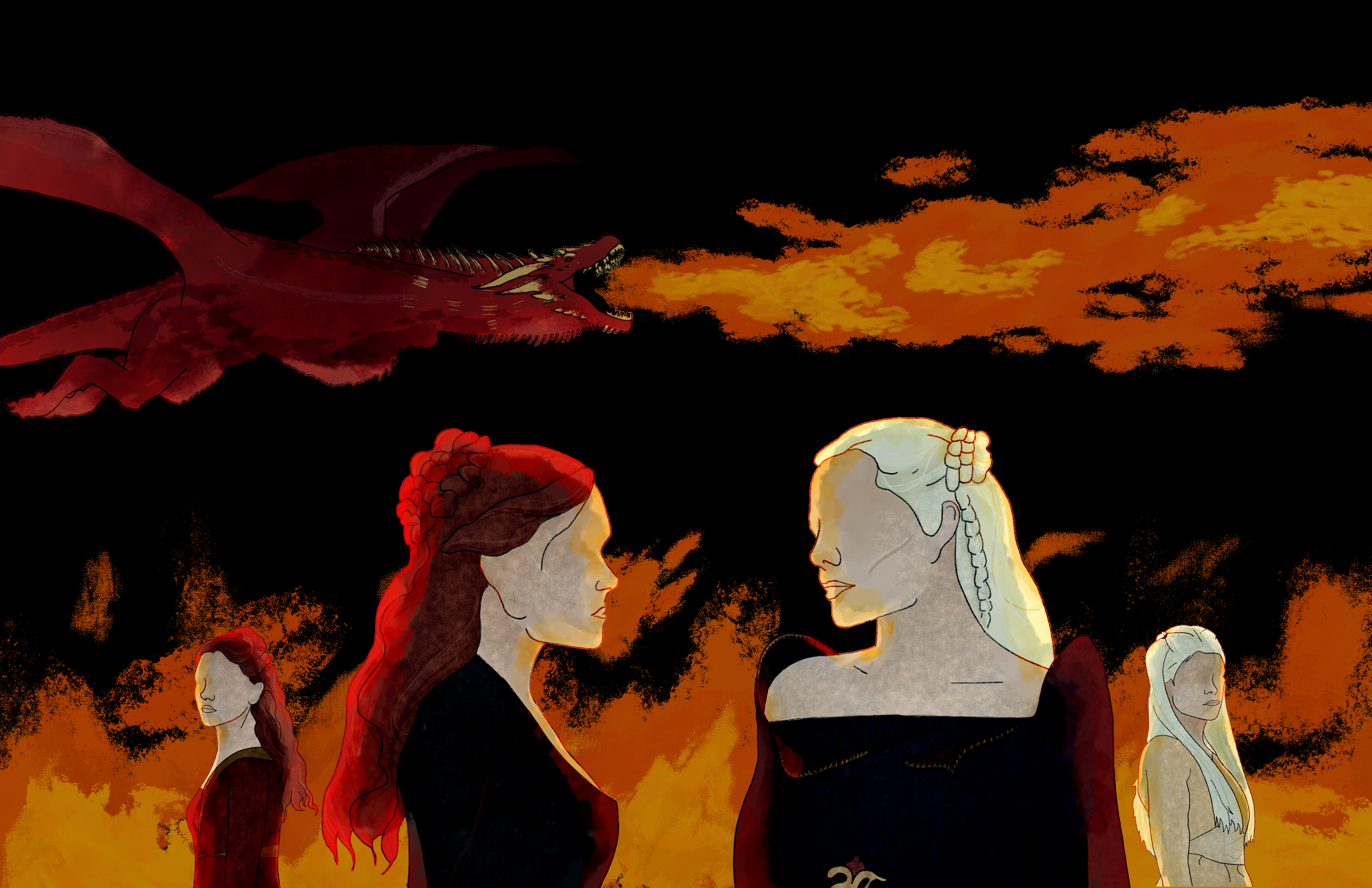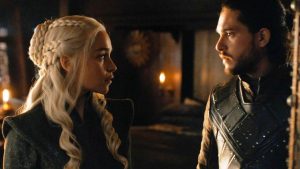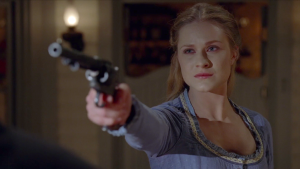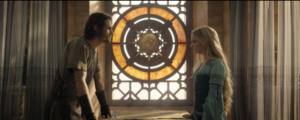Content warning: This article includes references to sexual violence.
In a dark, imposing war room, a bleach blonde dragon-rider musters forces to war against male claimants to her throne. You would not be remiss to think this is a description of the disastrous seventh season of Game of Thrones, but a new Targaryen queen has entered the scene and is vying for succession in House of the Dragon. HBO’s new spin-off prequel to the beloved, behated, and ever-debated Game of Thrones takes place nearly 200 years earlier and carries much of the same imagery, themes, and appeal as its predecessor. Yet, House of the Dragon’s first season, despite being borne on the backs of several CGI dragons, takes a bit longer to reach the same heights.
Where Game of Thrones paired a sweeping, multiregional, and multicultural scope with a similarly epic storyline, House of the Dragon’s inaugural season relies more heavily on interpersonal drama. Despite the enormous budget, there is something far more intimate, even restrained, about House of the Dragon. At its core, it is a story of a deeply dysfunctional family, mired by arrogance, ambition, lurid desires, and the complications of Westerosi politics.
Taken from George R.R. Martin’s Fire & Blood, a fictitious history of the Targaryen family, the series details the events of “the Dance of Dragons”—the civil war that annihilates the last of the dragons and signals the beginning of the end for the Targaryen family. This first season chronicles the beginning of the conflict between Rhaenyra Targaryen (Milly Alcock, later Emma D’Arcy) and her childhood friend-turned-stepmother Alicent Hightower (Emily Carey and Olivia Cooke). As Rhaenyra’s father King Viserys (Paddy Considine) becomes ever sicker with an unnamed but fatal disease, the two young women vie for influence, power, and the security of their lineages. Much like the first few seasons of GOT, it is a struggle for succession.
Fire & Blood is a history compiled by one fictional Maester Gyldayn, who states within the text that the sources he is drawing upon are inconclusive and unreliable, often relying on rumor and the records of a court fool named Mushroom. Therefore, within the Thrones lore, the source material for House of the Dragon is neither narrative nor is it necessarily faithful to the “true” occurrences within Martin’s world. As one Polygon review put it, the show is then “free of the burden of adaptation,” with showrunner Ryan Condal and his writing team working to spin original and intimate stories from pieces of Maester Gyldayn’s dubious history. House of the Dragon uses this latitude to focus heavily on interior politicking, passionate relationships, and significant glances—though it does not always succeed, the series is attempting to humanize and provide motivation for a set of otherwise featureless chess pieces.
In another more obvious departure from Game of Thrones, House of the Dragon liberally utilizes time skips. The first five episodes take place across four years of Rhaenyra’s youth, with a three-year time jump between episodes two and three. The latter half of the season takes place 10 years later, followed by an additional six-year time jump to end the season almost 20 years after it started. This halfway point is also marked by casting changes for our two rival queens.
These pacing and casting decisions were made to provide context for the latter half of the season where the true conflict for succession begins, but end up lending an unfortunate unevenness to the structure of the season. Though many fans adore these early episodes for the performances by Alcock and Carey, the narrative ends up feeling fragmented, making it particularly hard to reconcile the mischievous, spunky portrayal of adolescent Rhaenyra with her cool, sharp, and wry adult self. Similarly, how can we reconcile the hopeful yet timid teenage Alicent with her more controlled and calculating persona 10 years later? The 10-year gap at times feels momentous (Rhaenyra and Alicent have grown and changed exponentially) and at other times minuscule (Is Criston Cole (Fabien Frankel) really still this mad at Rhaenyra’s rejection 10 whole years later?). This uncertainty in the significance of the time jumps disjoints the pacing of the season, which leaves viewers wondering what exactly happened in all that time off-screen.
The early episodes themselves reflect this sort of narrative uncertainty. Though they establish backstories and relationships between the main players, in these first few episodes the stakes have not yet been properly set, making characters’ supposedly momentous decisions feel inconsequential at best and downright silly at worst. A particularly useless bit of screen time is given to Prince Daemon’s (Matt Smith) lengthy battle with a pirate named Crab Feeder (Daniel Scott-Smith), which does nothing but establish that he is an experienced soldier. While the first half of the season provides context for the meat of the story, it simply does not do enough leg work to justify being a significant chunk of the narrative.
That being said, once it passes the hump of this transition in the timeline, House of the Dragon truly begins to spread its wings—meticulously examining a painful struggle for power, freedom, and life between two women who were once friends. One of the most satisfying divergences House of the Dragon takes from its predecessor is its portrayal of female friendship against court intrigue. Young Alicent and Rhaenyra’s friendship is one of the more heartwarming aspects of the first half of the season, and portrayals of their burgeoning sexualities lend the relationship an erotic undertone. Carey, a queer actor, has stated that she played an Alicent unsure of the boundaries between romantic and platonic. Their relationship is compelling, however, because it’s affected by forces that remain largely out of their control; their choices are set by moves their fathers made while they were children, pieces placed years in the making.
The stakes heighten with the introduction of Alicent and Rhaenyra’s children. The question of succession extending to their children makes every conflict more dire and more brutal—particularly as the king’s health declines. Fabulous, biting performances by D’Arcy and Cooke are bolstered by sharp writing and production, adding depth and intimacy to a conflict quickly spiraling out of control. The writing team beautifully builds suspense in the final three episodes as we watch what was once a personal and political rivalry become an inevitable war. Alicent in particular is a deeply complicated and well-written character grappling with conflicting morality, desperation, and cold-blooded self-preservation.
Yet the reception of Queen Alicent has been particularly divisive. Fans have been quick to vilify her as power hungry or overly ambitious, condemning her as a bad mother and a bad friend. Yet these criticisms tend to attribute more agency to the character than the show actually suggests. Alicent and Rhaenyra demonstrate two markedly different forms of female agency in this extremely patriarchal fictional society. Rhaenyra’s character may be more appealing because she can directly challenge patriarchal norms, due to the privilege that her family name and position allow her. Alicent, her foil, must operate within those norms because she doesn’t have the privilege of a birthright claim to the throne (or a fire-breathing dragon). She displays more political savvy than Rhaenyra precisely because she understands the unfavorability of Rhaenyra’s ascension among the nobles and the peasants of Westeros alike, and predicts how the impending civil war will endanger her family. Most of the show is filmed from the perspective of Rhaenyra’s party, the Blacks, positioning Alicent and the Greens as antagonists. To dismiss Alicent as a simple villain would disregard her motivations and the political context she navigates. The shape of each woman’s agency is determined by their respective social positions as much as it is by their own wills and ambitions.
Where the full scope of Alicent’s character is demonstrated in the latter half of the season, the one true and shining constant throughout both halves of an uneven series is Paddy Considine’s King Viserys. Though inarguably a rather weak-willed king, Viserys is the moral heart of this first season. He is peace-seeking and just. He loves his unruly brother and is as quick to punish him for his misdeeds as he is to forgive him. Most importantly, time and time again, he reasserts his faith in and support for Rhaenyra, his firstborn child and heir to the throne, despite the many protestations towards her right to rule and (occasionally accurate) accusations of her inappropriate sexual relations. Viserys, plagued by what appears to be a type of leprosy, simply wants to see his family happy and whole, despite their best attempts to destroy each other. He is not a great ruler or a great king, but it is incontrovertible that his heart is in the right place. Viserys’ last appearance in episode eight, “Lord of the Tides,” is a deeply moving portrayal of sickness, love, and death—his struggle and longing for peace cementing the episode as perhaps the strongest of the whole season.
House of the Dragon departs from Game of Thrones in many ways, from its narrowed scope to its stilted pacing, yet some issues of the original series have wormed their way into the spin-off as well. While the show’s depictions of sex have softened, its depictions of violence have only grown more brutal. Where once there were simple decapitations and stabbings there are now decapitations through the cheekbone and tongues rolling out of half-headless carcasses.
And, like a plague that hounds George R.R. Martin’s work, no story of Westeros is complete without the brutalization of women’s bodies. House of the Dragon is far more restrained in its portrayals of nudity and rape, yet it has instead shifted to absolutely agonizing portrayals of childbirth. The season opens with a graphic and drawn-out forced C-section on Queen Aemma (Sian Brooke), authorized by her husband, while the woman screams her refusal. The season ends with a similarly bloody and drawn-out miscarriage in the finale, an episode overlaid with Rhaenyra’s wails of agony as background noise. Both depictions of childbirth function as points of abject horror in the show, and they make women’s suffering a central aspect of the story. In the current context of renewed political battles over women’s reproductive rights, these scenes reflect popular anxieties about the violence of childbirth by unnatural deliveries and the demands placed on the female body when in positions of power and leadership.
While these life-threatening struggles with childbirth are certainly accurate for the vaguely Medieval period that Martin is invoking, and are arguably being utilized to show a different form of violence against women, the scenes are gratuitous and, for young women, deeply, deeply, deeply uncomfortable. This exploitation of female bodies in pain veers into trauma porn, especially given the high proportion of young male viewers. Perhaps one of these days, the Game of Thrones writers will understand that they do not have to graphically depict the specific horrors of childbirth and rape to demonstrate pain.
On a similar note, it is hard to write about House of the Dragon or the Targaryens in general without addressing the bleach-blonde elephant in the room. Yes, there is a lot of incest. And not only is it treated as normal, it is, in the case of Daemon and Rhaenyra, seemingly reified. Their story is treated as an imperfect romance rather than a critical example of grooming, which is abuse. And with the way Twitter is fiending for more of their relationship, it does not seem as though this glorified incest will be portrayed differently any time soon. Frankly, dear reader, these humble reviewers are not surprised, but would just like to let out an almighty sigh of defeat.
Despite its pitfalls—and sure, it has its fair share—House of the Dragon is only getting better. If it can learn from its predecessor’s mistakes, the best may still be to come. With moving performances, polished writing, and a complex and brutal conflict awaiting us, House of the Dragon has shaken off its stuttering start and taken off on dragonback. Whether it will be able to control its momentum, like a certain dragonrider in the finale, is still up in the air.





